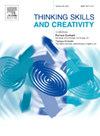利用设计思维实践学习提高人工智能应用的创造力:脑电波研究
IF 3.7
2区 教育学
Q1 Social Sciences
引用次数: 0
摘要
在人工智能(AI)飞速发展的时代,培养人工智能能力和创新精神对于提高个人、企业和国家竞争力至关重要。本研究探讨了设计思维实践学习(HLDT)对参与人工智能任务的参与者的创造性表现和脑电波的影响。研究对象包括来自两个班级的 67 名公立大学学生,他们也是职前教师。实验组接受了 HLDT,而对比组则接受了以多媒体讲座为基础的设计思维教学。我们发现,HLDT 对学生创造的产品的新颖性、可行性和价值都有明显的积极影响。对新颖性的影响最大。此外,它还对创意过程的各个阶段,包括发现、定义、构思、实施和完善,产生了明显的积极影响。对完善阶段的影响最为明显。最后,在发现阶段,它能促进更高水平的冥想,使人感到更加放松,并表现出较低的β和γ活动。在构思阶段,它还能提高注意力和冥想水平,有助于发散思维。基于这些研究结果,我们提出了关于 HLDT 的合适情境和关键教学内容的实用教学建议。此外,我们还提出了未来的研究领域。本文章由计算机程序翻译,如有差异,请以英文原文为准。
Using design thinking hands-on learning to improve artificial intelligence application creativity: A study of brainwaves
In an era of rapidly developing artificial intelligence (AI), nurturing AI proficiency and innovation is critical to enhance individual, corporate, and national competitiveness. This study explored the effects of hands-on learning of design thinking (HLDT) on the creative performance and brainwaves of participants involved in an AI task. The study included 67 public university students from two classes who were also pre-service teachers. The experimental group received HLDT, while the comparison group received multimedia lecture-based instruction about DT. We found that HLDT significantly positively affected the novelty, feasibility, and value of the products that were created by the students. The effect on novelty was most substantial. In addition, it significantly positively affected various stages of the creative process, including discovery, definition, ideation, implementation, and refining. The effect on the refining stage was the most pronounced. Finally, it promoted higher levels of meditation during the discovery stage, with individuals feeling more relaxed and exhibiting lower beta and gamma activity. It also encouraged higher levels of attention and meditation during the ideation stage, aiding divergent thinking. Based on these findings, we propose practical teaching recommendations for suitable contexts and key instructional content for HLDT. Additionally, we suggest areas for future research.
求助全文
通过发布文献求助,成功后即可免费获取论文全文。
去求助
来源期刊

Thinking Skills and Creativity
EDUCATION & EDUCATIONAL RESEARCH-
CiteScore
6.40
自引率
16.20%
发文量
172
审稿时长
76 days
期刊介绍:
Thinking Skills and Creativity is a new journal providing a peer-reviewed forum for communication and debate for the community of researchers interested in teaching for thinking and creativity. Papers may represent a variety of theoretical perspectives and methodological approaches and may relate to any age level in a diversity of settings: formal and informal, education and work-based.
 求助内容:
求助内容: 应助结果提醒方式:
应助结果提醒方式:


